Childbirth
| Childbirth | |
|---|---|
| Synonyms | Labour and delivery, partus, parturition, birth |
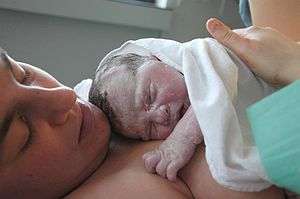 | |
| Newborn baby and mother | |
| Specialty | Obstetrics, midwifery |
| Complications | Obstructed labour, postpartum bleeding, eclampsia, postpartum infection, birth asphyxia[1][2] |
| Types | Vaginal delivery, C-section[3][4] |
| Frequency | 135 million (2015)[5] |
| Deaths | 500,000 maternal deaths a year |
Childbirth, also known as labour and delivery, is the ending of a pregnancy by one or more babies leaving a woman's uterus by vaginal passage or Caesarean section.[4] In 2015, there were about 135 million births globally.[5] About 15 million were born before 37 weeks of gestation,[6] while between 3 and 12% were born after 42 weeks.[7] In the developed world most deliveries occur in hospital,[8][9] while in the developing world most births take place at home with the support of a traditional birth attendant.[10]
The most common way of childbirth is a vaginal delivery.[3] It involves three stages of labour: the shortening and opening of the cervix, descent and birth of the baby, and the delivery of the placenta.[11] The first stage typically lasts twelve to nineteen hours, the second stage twenty minutes to two hours, and the third stage five to thirty minutes.[12] The first stage begins with crampy abdominal or back pains that last around half a minute and occur every ten to thirty minutes.[11] The crampy pains become stronger and closer together over time.[12] During the second stage pushing with contractions may occur.[12] In the third stage delayed clamping of the umbilical cord is generally recommended.[13] A number of methods can help with pain such as relaxation techniques, opioids, and spinal blocks.[12]
Most babies are born head first; however about 4% are born feet or buttock first, known as breech.[12][14] During labour a woman can generally eat and move around as she likes, but pushing is not recommended during the first stage or during delivery of the head, and enemas are not recommended.[15] While making a cut to the opening of the vagina, known as an episiotomy, is common, it is generally not needed.[12] In 2012, about 23 million deliveries occurred by a surgical procedure known as Caesarean section.[16] Caesarean sections may be recommended for twins, signs of distress in the baby, or breech position.[12] This method of delivery can take longer to heal from.[12]
Each year, complications from pregnancy and childbirth result in about 500,000 maternal deaths, 7 million women have serious long term problems, and 50 million women have negative health outcomes following delivery.[2] Most of these occur in the developing world.[2] Specific complications include obstructed labour, postpartum bleeding, eclampsia, and postpartum infection.[2] Complications in the baby may include lack of oxygen at birth, birth trauma, prematurity, and infections.[1][17]
Signs and symptoms
.jpg)
The most prominent sign of labour is strong repetitive uterine contractions. The distress levels reported by labouring women vary widely. They appear to be influenced by fear and anxiety levels, experience with prior childbirth, cultural ideas of childbirth and pain,[18][19] mobility during labour, and the support received during labour. Personal expectations, the amount of support from caregivers, quality of the caregiver-patient relationship, and involvement in decision-making are more important in women's overall satisfaction with the experience of childbirth than are other factors such as age, socioeconomic status, ethnicity, preparation, physical environment, pain, immobility, or medical interventions.[20]
Descriptions
Pain in contractions has been described as feeling similar to very strong menstrual cramps. Women are often encouraged to refrain from screaming, but moaning and grunting may be encouraged to help lessen pain. Crowning may be experienced as an intense stretching and burning. Even women who show little reaction to labour pains, in comparison to other women, show a substantially severe reaction to crowning.
Back labour is a term for specific pain occurring in the lower back, just above the tailbone, during childbirth.[21]
Psychological
During the later stages of gestation there is an increase in abundance of oxytocin, a hormone that is known to evoke feelings of contentment, reductions in anxiety, and feelings of calmness and security around the mate.[22] Oxytocin is further released during labour when the fetus stimulates the cervix and vagina, and it is believed that it plays a major role in the bonding of a mother to her infant and in the establishment of maternal behavior. The act of nursing a child also causes a release of oxytocin.[23]
Between 70% and 80% of mothers in the United States report some feelings of sadness or "baby blues" after giving birth. The symptoms normally occur for a few minutes up to few hours each day and they should lessen and disappear within two weeks after delivery. Postpartum depression may develop in some women; about 10% of mothers in the United States are diagnosed with this condition. Preventive group therapy has proven effective as a prophylactic treatment for postpartum depression.[24][25]
Vaginal birth
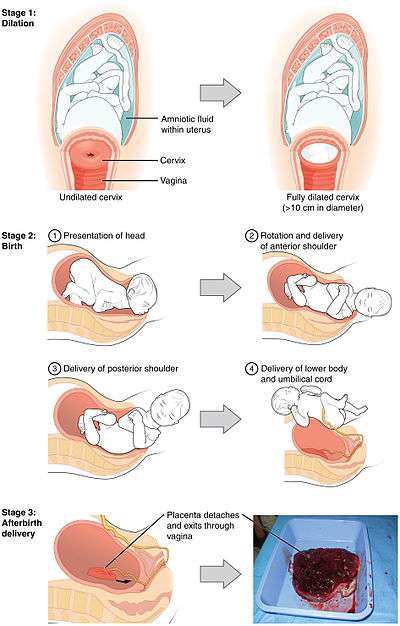
Humans are bipedal with an erect stance. The erect posture causes the weight of the abdominal contents to thrust on the pelvic floor, a complex structure which must not only support this weight but allow, in women, three channels to pass through it: the urethra, the vagina and the rectum. The infant's head and shoulders must go through a specific sequence of maneuvers in order to pass through the ring of the mother's pelvis.
Six phases of a typical vertex or cephalic (head-first presentation) delivery:
- Engagement of the fetal head in the transverse position. The baby's head is facing across the pelvis at one or other of the mother's hips.
- Descent and flexion of the fetal head.
- Internal rotation. The fetal head rotates 90 degrees to the occipito-anterior position so that the baby's face is towards the mother's rectum.
- Delivery by extension. The fetal head is bowed, chin on chest, so that the back or crown of its head leads the way through the birth canal, until the back of its neck presses against the pubic bone and its chin leaves its chest, extending the neck - as if to look up, and the rest of its head passes out of the birth canal.
- Restitution. The fetal head turns through 45 degrees to restore its normal relationship with the shoulders, which are still at an angle.
- External rotation. The shoulders repeat the corkscrew movements of the head, which can be seen in the final movements of the fetal head.
The vagina is called a 'birth canal' when the baby enters this passage.
Station refers to the relationship of the fetal presenting part to the level of the ischial spines. When the presenting part is at the ischial spines the station is 0 (synonymous with engagement). If the presenting fetal part is above the spines, the distance is measured and described as minus stations, which range from −1 to −4 cm. If the presenting part is below the ischial spines, the distance is stated as plus stations ( +1 to +4 cm). At +3 and +4 the presenting part is at the perineum and can be seen.[26]
The fetal head may temporarily change shape substantially (becoming more elongated) as it moves through the birth canal. This change in the shape of the fetal head is called molding and is much more prominent in women having their first vaginal delivery.[27]
Cervical ripening is a term used to describe the physical and chemical changes in the cervix to prepare it for the stretching that will take place as the fetus moves out of the uterus and into the birth canal. A scoring system called a Bishop score can be used to judge the degree of cervical ripening in order to predict the timing of labor and delivery of the infant or for women at risk for preterm labor. It is also used to judge when a woman will respond to induction of labor for a postdate pregnancy or other medical reasons. There are several methods of inducing cervical ripening which will allow the uterine contractions to effectively dilate the cervix.[28]
Onset of labour
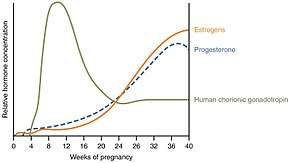
There are various definitions of the onset of labour, including:
- Regular uterine contractions at least every six minutes with evidence of change in cervical dilation or cervical effacement between consecutive digital examinations.[29]
- Regular contractions occurring less than 10 min apart and progressive cervical dilation or cervical effacement.[30]
- At least 3 painful regular uterine contractions during a 10-minute period, each lasting more than 45 seconds.[31]
In order to avail for more uniform terminology, the first stage of labour is divided into "latent" and "active" phases, where the latent phase is sometimes included in the definition of labour,[32] and sometimes not.[33]
Common signs that labour is about to begin may include "lightening". Lightening describes the baby moving down from the rib cage with the head of the baby engaging deep in the pelvis. The pregnant woman may then find breathing easier since her lungs have more room for expansion, but pressure on her bladder may cause more frequent need to void (urinate). Lightening may occur a few weeks or a few hours before labour begins, or even not until labour has begun.[34]
Some women also experience an increase in vaginal discharge several days before labour begins when the "mucus plug", a thick plug of mucus that blocks the opening to the uterus, is pushed out into the vagina. The mucus plug may become dislodged days before labour begins or not until the start of labour.[34]
While living inside the uterus the baby is enclosed in a fluid-filled membrane called the amniotic sac. Shortly before, at the beginning of, or during labor the sac ruptures. Once the sac ruptures, termed "the water breaks", the baby is at risk for infection and the mother's medical team will assess the need to induce labor if it has not started within the time they believe to be safe for the infant.[34]
Many women are known to experience what has been termed the "nesting instinct". Women report a spurt of energy shortly before going into labour.[34]
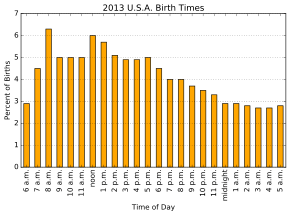
Folklore has long held that most babies are born in the late night or very early morning and recent (2018) research has found this to be correct in the U.S., but only for babies born at home or on Saturday or Sunday. All other births are most likely to occur between 8 a.m. and noon, a reflection of the fact that planned C-sections are generally scheduled for 8 a.m. Likewise, births from induced deliveries rose during the morning hours and peaked at 3 p.m. The most likely day of the week for a baby's birthday in the U.S. is Monday, followed by Tuesday, likely related to scheduled deliveries as well.[35][36]
First stage: latent phase
The latent phase is generally defined as beginning at the point at which the woman perceives regular uterine contractions.[37] In contrast, Braxton Hicks contractions, which are contractions that may start around 26 weeks gestation and are sometimes called "false labour", are infrequent, irregular, and involve only mild cramping.[38]
Cervical effacement, which is the thinning and stretching of the cervix, and cervical dilation occur during the closing weeks of pregnancy. Effacement is usually complete or near complete and dilation is about 5 cm by the end of the latent phase.[39] The degree of cervical effacement and dilation may be felt during a vaginal examination. The latent phase ends with the onset of the active first stage.
First stage: active phase
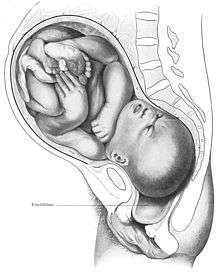
The active stage of labour (or "active phase of first stage" if the previous phase is termed "latent phase of first stage") has geographically differing definitions. The World Health Organization describes the active first stage as "a period of time characterized by regular painful uterine contractions, a substantial degree of cervical effacement and more rapid cervical dilatation from 5 cm until full dilatation for first and subsequent labours.[40] In the US, the definition of active labour was changed from 3 to 4 cm, to 5 cm of cervical dilation for multiparous women, mothers who had given birth previously, and at 6 cm for nulliparous women, those who had not given birth before.[41] This was done in an effort to increase the rates of vaginal delivery.[42]
Health care providers may assess a labouring mother's progress in labour by performing a cervical exam to evaluate the cervical dilation, effacement, and station. These factors form the Bishop score. The Bishop score can also be used as a means to predict the success of an induction of labour.
During effacement, the cervix becomes incorporated into the lower segment of the uterus. During a contraction, uterine muscles contract causing shortening of the upper segment and drawing upwards of the lower segment, in a gradual expulsive motion. The presenting fetal part then is permitted to descend. Full dilation is reached when the cervix has widened enough to allow passage of the baby's head, around 10 cm dilation for a term baby.
A standard duration of the latent first stage has not been established and can vary widely from one woman to another. However, the duration of active first stage (from 5 cm until full cervical dilatation) usually does not extend beyond 12 hours in first labours ("primiparae"), and usually does not extend beyond 10 hours in subsequent labours ("multiparae"). The median duration of active first stage is 4 hours in first labours and 3 hours in second and subsequent labours.[43]
Dystocia of labor, also termed dysfunctional labor or failure to progress, is defined as difficult labor or abnormally slow progress of labor. The term is used to describe a lack of progressive cervical dilatation or lack of descent of the fetus. Friedman's Curve, developed in 1955, was for many years used to determine labor dystocia. However, more recent medical research suggests that the Friedman curve may not be currently applicable.[44][45]
Second stage: fetal expulsion
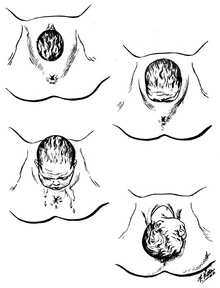
The expulsion stage begins when the cervix is fully dilated, and ends when the baby is born. As pressure on the cervix increases, women may have the sensation of pelvic pressure and an urge to begin pushing. At the beginning of the normal second stage, the head is fully engaged in the pelvis; the widest diameter of the head has passed below the level of the pelvic inlet. The fetal head then continues descent into the pelvis, below the pubic arch and out through the vaginal introitus (opening). This is assisted by the additional maternal efforts of "bearing down" or pushing. The appearance of the fetal head at the vaginal orifice is termed the "crowning". At this point, the woman will feel an intense burning or stinging sensation.
When the amniotic sac has not ruptured during labour or pushing, the infant can be born with the membranes intact. This is referred to as "delivery en caul".
Complete expulsion of the baby signals the successful completion of the second stage of labour.
The second stage varies from one woman to another. In first labours, birth is usually completed within 3 hours whereas in subsequent labours, birth is usually completed within 2 hours.[46] Labours longer than 3 hours are associated with declining rates of spontaneous vaginal delivery and increasing rates of infection, perineal tears, and obstetric hemorrhage, as well as the need for intensive care of the neonate.[47]
Third stage: placenta delivery
The period from just after the fetus is expelled until just after the placenta is expelled is called the third stage of labour or the involution stage. Placental expulsion begins as a physiological separation from the wall of the uterus. The average time from delivery of the baby until complete expulsion of the placenta is estimated to be 10–12 minutes dependent on whether active or expectant management is employed.[48] In as many as 3% of all vaginal deliveries, the duration of the third stage is longer than 30 minutes and raises concern for retained placenta.[49]
Placental expulsion can be managed actively or it can be managed expectantly, allowing the placenta to be expelled without medical assistance. Active management is described as the administration of a uterotonic drug within one minute of fetal delivery, controlled traction of the umbilical cord and fundal massage after delivery of the placenta, followed by performance of uterine massage every 15 minutes for two hours.[50] In a joint statement, World Health Organization, the International Federation of Gynaecology and Obstetrics and the International Confederation of Midwives recommend active management of the third stage of labour in all vaginal deliveries to help to prevent postpartum hemorrhage.[51][52][53]
Delaying the clamping of the umbilical cord for at least one minute or until it ceases to pulsate, which may take several minutes, improves outcomes as long as there is the ability to treat jaundice if it occurs. For many years it was believed that late cord cutting led to a mother's risk of experiencing significant bleeding after giving birth, called postpartum bleeding. However a recent review found that delayed cord cutting in healthy full-term infants resulted in early haemoglobin concentration and higher birthweight and increased iron reserves up to six months after birth with no change in the rate of postpartum bleeding.[54][55]
Fourth stage
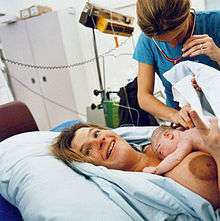
The "fourth stage of labour" is the period beginning immediately after the birth of a child and extending for about six weeks. The terms postpartum and postnatal are often used to describe this period.[56] The woman's body, including hormone levels and uterus size, return to a non-pregnant state and the newborn adjusts to life outside the mother's body. The World Health Organization (WHO) describes the postnatal period as the most critical and yet the most neglected phase in the lives of mothers and babies; most deaths occur during the postnatal period.[57]
Following the birth, if the mother had an episiotomy or a tearing of the perineum, it is stitched. The mother has regular assessments for uterine contraction and fundal height,[58] vaginal bleeding, heart rate and blood pressure, and temperature, for the first 24 hours after birth. The first passing of urine should be documented within 6 hours.[57] Afterpains (pains similar to menstrual cramps), contractions of the uterus to prevent excessive blood flow, continue for several days. Vaginal discharge, termed "lochia", can be expected to continue for several weeks; initially bright red, it gradually becomes pink, changing to brown, and finally to yellow or white.[59] Some women experience an uncontrolled episode of shivering or postpartum chills, after the birth.
Most authorities suggest the infant be placed in skin-to-skin contact with the mother for 1–2 hours immediately after birth, putting routine cares off until later.
Until recently babies born in hospitals were removed from their mothers shortly after birth and brought to the mother only at feeding times. Mothers were told that their newborn would be safer in the nursery and that the separation would offer the mother more time to rest. As attitudes began to change, some hospitals offered a "rooming in" option wherein after a period of routine hospital procedures and observation, the infant could be allowed to share the mother's room. However, more recent information has begun to question the standard practice of removing the newborn immediately postpartum for routine postnatal procedures before being returned to the mother. Beginning around 2000, some authorities began to suggest that early skin-to-skin contact (placing the naked baby on the mother's chest) may benefit both mother and infant. Using animal studies that have shown that the intimate contact inherent in skin-to-skin contact promotes neurobehaviors that result in the fulfillment of basic biological needs as a model, recent studies have been done to assess what, if any, advantages may be associated with early skin-to-skin contact for human mothers and their babies. A 2011 medical review looked at existing studies and found that early skin-to-skin contact, sometimes called kangaroo care, resulted in improved breastfeeding outcomes, cardio-respiratory stability, and a decrease in infant crying. [60][61] A 2016 Cochrane review found that skin-to-skin contact at birth promotes the likelihood and effectiveness of breastfeeding.[62]
As of 2014, early postpartum skin-to-skin contact is endorsed by all major organizations that are responsible for the well-being of infants, including the American Academy of Pediatrics.[63] The World Health Organization (WHO) states that "the process of childbirth is not finished until the baby has safely transferred from placental to mammary nutrition." They advise that the newborn be placed skin-to-skin with the mother, postponing any routine procedures for at least one to two hours. The WHO suggests that any initial observations of the infant can be done while the infant remains close to the mother, saying that even a brief separation before the baby has had its first feed can disturb the bonding process. They further advise frequent skin-to-skin contact as much as possible during the first days after delivery, especially if it was interrupted for some reason after the delivery.[64] The National Institute for Health and Care Excellence also advises postponing procedures such as weighing, measuring, and bathing for at least 1 hour to insure an initial period of skin-to-skin contact between mother and infant.[65]
Labour induction and elective Caesarean section
In many cases and with increasing frequency, childbirth is achieved through induction of labour or caesarean section. Caesarean section is the removal of the neonate through a surgical incision in the abdomen, rather than through vaginal birth.[66] Childbirth by C-Sections increased 50% in the U.S. from 1996 to 2006. In 2011, 32.8% of births in the U.S. were delivered by cesarean section.[66] Induced births and elective cesarean before 39 weeks can be harmful to the neonate as well as harmful or without benefit to the mother. Therefore, many guidelines recommend against non-medically required induced births and elective cesarean before 39 weeks.[67] The 2012 rate of labour induction in the United States was 23.3%, and has more than doubled from 1990 to 2010.[68][69] Pitocin is commonly used to induce uterine contractions. A large review of methods of induction was published in 2011.[70]
The American Congress of Obstetricians and Gynecologists (ACOG) guidelines recommend a full evaluation of the maternal-fetal status, the status of the cervix, and at least a 39 completed weeks (full term) of gestation for optimal health of the newborn when considering elective induction of labour. Per these guidelines, the following conditions may be an indication for induction, including:
- Abruptio placentae
- Chorioamnionitis
- Fetal compromise such as isoimmunization leading to hemolytic disease of the newborn or oligohydramnios
- Fetal demise
- Gestational hypertension
- Maternal conditions such as gestational diabetes or chronic kidney disease
- Preeclampsia or eclampsia
- Premature rupture of membranes
- Postterm pregnancy
Induction is also considered for logistical reasons, such as the distance from hospital or psychosocial conditions, but in these instances gestational age confirmation must be done, and the maturity of the fetal lung must be confirmed by testing. The ACOG also note that contraindications for induced labour are the same as for spontaneous vaginal delivery, including vasa previa, complete placenta praevia, umbilical cord prolapse or active genital herpes simplex infection.[71]
Management
Deliveries are assisted by a number of professionals including: obstetricians, family physicians and midwives. For low risk pregnancies all three result in similar outcomes.[72]
Preparation
Eating or drinking during labour is an area of ongoing debate. While some have argued that eating in labour has no harmful effects on outcomes,[73] others continue to have concern regarding the increased possibility of an aspiration event (choking on recently eaten foods) in the event of an emergency delivery due to the increased relaxation of the esophagus in pregnancy, upward pressure of the uterus on the stomach, and the possibility of general anesthetic in the event of an emergency cesarean.[74] A 2013 Cochrane review found that with good obstetrical anaesthesia there is no change in harms from allowing eating and drinking during labour in those who are unlikely to need surgery. They additionally acknowledge that not eating does not mean there is an empty stomach or that its contents are not as acidic. They therefore conclude that "women should be free to eat and drink in labour, or not, as they wish."[75]
At one time shaving of the area around the vagina, was common practice due to the belief that hair removal reduced the risk of infection, made an episiotomy (a surgical cut to enlarge the vaginal entrance) easier, and helped with instrumental deliveries. It is currently less common, though it is still a routine procedure in some countries even though a systematic review found no evidence to recommend shaving.[76] Side effects appear later, including irritation, redness, and multiple superficial scratches from the razor. Another effort to prevent infection has been the use of the antiseptic chlorhexidine or providone-iodine solution in the vagina. Evidence of benefit with chlorhexidine is lacking.[77] A decreased risk is found with providone-iodine when a cesarean section is to be performed.[78]
Active management of labour
In 2013 a review of the effectiveness of active management for reducing caesarean section rates in low-risk women was carried out. Active management of labour consists of a number of care principles, including "strict diagnosis of labour", routine artificial rupture of membranes, oxytocin for slow progress, and one-to-one support. The review reported that when compared to routine care there were no differences in the use of medications for pain, maternal or neonatal complications, or rates of assisted vaginal deliveries. There was a slight reduction in the caesarean section rate, however active management was seen as "highly prescriptive and interventional."[79]
The World Health Organization advises: "Avoid the systematic use of a package of interventions (“active management of labour”) to prevent possible labour delay because it is highly prescriptive and can undermine women’s choices and autonomy during care."[80]
Pain control
Non pharmaceutical
Some women prefer to avoid analgesic medication during childbirth. Psychological preparation may be beneficial. Relaxation techniques, immersion in water, massage, and acupuncture may provide pain relief. Acupuncture and relaxation were found to decrease the number of caesarean sections required.[81] Immersion in water has been found to relieve pain during the first stage of labor and to reduce the need for anesthesia and shorten the duration of labor, however the safety and efficacy of immersion during birth, water birth, has not been established or associated with maternal or fetal benefit.[82]
Most women like to have someone to support them during labour and birth; such as a midwife, nurse, or doula; or a lay person such as the father of the baby, a family member, or a close friend. Studies have found that continuous support during labor and delivery reduce the need for medication and a caesarean or operative vaginal delivery, and result in an improved Apgar score for the infant.[83][84]
Pharmaceutical
Different measures for pain control have varying degrees of success and side effects to the woman and her baby. In some countries of Europe, doctors commonly prescribe inhaled nitrous oxide gas for pain control, especially as 53% nitrous oxide, 47% oxygen, known as Entonox; in the UK, midwives may use this gas without a doctor's prescription. Opioids such as fentanyl may be used, but if given too close to birth there is a risk of respiratory depression in the infant.
Popular medical pain control in hospitals include the regional anesthetics epidurals (EDA), and spinal anaesthesia. Epidural analgesia is a generally safe and effective method of relieving pain in labour, but is associated with longer labour, more operative intervention (particularly instrument delivery), and increases in cost.[85] However, a recent Cochrane review suggests that the new epidural techniques have no more effect on labour time and the used instruments.[86] Generally, pain and stress hormones rise throughout labour for women without epidurals, while pain, fear, and stress hormones decrease upon administration of epidural analgesia, but rise again later.[87] Medicine administered via epidural can cross the placenta and enter the bloodstream of the fetus.[88] Epidural analgesia has no statistically significant impact on the risk of caesarean section, and does not appear to have an immediate effect on neonatal status as determined by Apgar scores.[86]
Augmentation
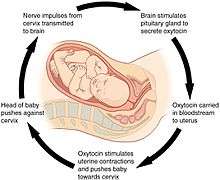
Augmentation is the process of stimulating the uterus to increase the intensity and duration of contractions after labour has begun. Several methods of augmentation are commonly been used to treat slow progress of labour (dystocia) when uterine contractions are assessed to be too weak. Oxytocin is the most common method used to increase the rate of vaginal delivery.[89] The World Health Organization recommends its use either alone or with amniotomy (rupture of the amniotic membrane) but advises that it must be used only after it has been correctly confirmed that labour is not proceeding properly if harm is to be avoided. The WHO does not recommend the use of antispasmodic agents for prevention of delay in labour.[90]
Episiotomy
Perineal tears can occur during childbirth, most often at the vaginal opening as the baby's head passes through, especially if the baby descends quickly. Tears can involve the perineal skin or extend to the muscles and the anal sphincter and anus. While making a cut to the opening of the vagina, known as an episiotomy is common, it is generally not needed.[12] When needed, the midwife or obstetrician makes a surgical cut in the perineum to prevent severe tears that can be difficult to repair. A 2017 Cochrane review compared episiotomy as needed (restrictive) with routine episiotomy to determine the possible benefits and harms for mother and baby. The review found that restrictive episiotomy policies appeared to give a number of benefits compared with using routine episiotomy. Women experienced less severe perineal trauma, less posterior perineal trauma, less suturing and fewer healing complications at seven days with no difference in occurrence of pain, urinary incontinence, painful sex or severe vaginal/perineal trauma after birth.[91]
Instrumental delivery
Obstetric forceps or ventouse may be used to facilitate childbirth.
Multiple births
In cases of a head first-presenting first twin, twins can often be delivered vaginally. In some cases twin delivery is done in a larger delivery room or in an operating theatre, in the event of complication e.g.
- Both twins born vaginally—this can occur both presented head first or where one comes head first and the other is breech and/or helped by a forceps/ventouse delivery
- One twin born vaginally and the other by caesarean section.
- If the twins are joined at any part of the body—called conjoined twins, delivery is mostly by caesarean section.
Support

Obstetric care frequently subjects women to institutional routines, which may have adverse effects on the progress of labour. Supportive care during labour may involve emotional support, comfort measures, and information and advocacy which may promote the physical process of labour as well as women's feelings of control and competence, thus reducing the need for obstetric intervention. The continuous support may be provided either by hospital staff such as nurses or midwives, doulas, or by companions of the woman's choice from her social network. There is increasing evidence to show that the participation of the child's father in the birth leads to better birth and also post-birth outcomes, providing the father does not exhibit excessive anxiety.[92]
A recent Cochrane review involving more than 15,000 women in a wide range of settings and circumstances found that "Women who received continuous labour support were more likely to give birth 'spontaneously', i.e. give birth with neither caesarean nor vacuum nor forceps. In addition, women were less likely to use pain medications, were more likely to be satisfied, and had slightly shorter labours. Their babies were less likely to have low five-minute Apgar scores."[83]
Fetal monitoring
External monitoring
For monitoring of the fetus during childbirth, a simple pinard stethoscope or doppler fetal monitor ("doptone") can be used. A method of external (noninvasive) fetal monitoring (EFM) during childbirth is cardiotocography, using a cardiotocograph that consists of two sensors: The heart (cardio) sensor is an ultrasonic sensor, similar to a Doppler fetal monitor, that continuously emits ultrasound and detects motion of the fetal heart by the characteristic of the reflected sound. The pressure-sensitive contraction transducer, called a tocodynamometer (toco) has a flat area that is fixated to the skin by a band around the belly. The pressure required to flatten a section of the wall correlates with the internal pressure, thereby providing an estimate of contraction.[93] Monitoring with a cardiotocograph can either be intermittent or continuous.[94] The World Health Organization (WHO) advises that for healthy women undergoing spontaneous labour continuous cardiotocography is not recommended for assessment of fetal well-being. The WHO states: "In countries and settings where continuous CTG is used defensively to protect against litigation, all stakeholders should be made aware that this practice is not evidence-based and does not improve birth outcomes."[95]
Internal monitoring
A mother's water has to break before internal (invasive) monitoring can be used. More invasive monitoring can involve a fetal scalp electrode to give an additional measure of fetal heart activity, and/or intrauterine pressure catheter (IUPC). It can also involve fetal scalp pH testing.
Complications
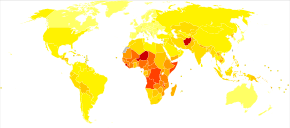

Per figures retrieved in 2015, since 1990 there has been a 44 per cent decline in the maternal death rate. However, according to 2015 figures 830 women die every day from causes related to pregnancy or childbirth and for every woman who dies, 20 or 30 encounter injuries, infections or disabilities. Most of these deaths and injuries are preventable.[97][98]
In 2008, noting that each year more than 100,000 women die of complications of pregnancy and childbirth and at least 7 million experience serious health problems while 50 million more have adverse health consequences after childbirth, the World Health Organization (WHO) has urged midwife training to strengthen maternal and newborn health services. To support the upgrading of midwifery skills the WHO established a midwife training program, Action for Safe Motherhood.[2]
The rising maternal death rate in the U.S. is of concern. In 1990 the U.S. ranked 12th of the 14 developed countries that were analyzed. However, since that time the rates of every country have steadily continued to improve while the U.S. rate has spiked dramatically. While every other developed nation of the 14 analyzed in 1990 shows a 2017 death rate of less than 10 deaths per every 100,000 live births, the U.S. rate has risen to 26.4. By comparison, the United Kingdom ranks second highest at 9.2 and Finland is the safest at 3.8.[99] Furthermore, for every one of the 700 to 900 U.S. woman who die each year during pregnancy or childbirth, 70 experience significant complications such as hemorrhage and organ failure, totaling more than 1 percent of all births.[100]
Compared to other developed nations, the United States also has high infant mortality rates. The Trust for America's Health reports that as of 2011, about one third of American births have some complications; many are directly related to the mother's health including increasing rates of obesity, type 2 diabetes, and physical inactivity. The U.S. Centers for Disease Control and Prevention (CDC) has led an initiative to improve woman's health previous to conception in an effort to improve both neonatal and maternal death rates.[101]
Labour and delivery complications
Obstructed labour
The second stage of labour may be delayed or lengthy due to poor or uncoordinated uterine action, an abnormal uterine position such as breech or shoulder dystocia, and cephalopelvic disproportion (a small pelvis or large infant). Prolonged labour may result in maternal exhaustion, fetal distress, and other complications including obstetric fistula. [102]
Eclampsia
Eclampsia is the onset of seizures (convulsions) in a woman with pre-eclampsia. Pre-eclampsia is a disorder of pregnancy in which there is high blood pressure and either large amounts of protein in the urine or other organ dysfunction. Pre-eclampsia is routinely screened for during prenatal care. Onset may be before, during, or rarely, after delivery. Around one percent of women with eclampsia die.
Maternal complications
A puerperal disorder or postpartum disorder is a complication which presents primarily during the puerperium, or postpartum period. The postpartum period can be divided into three distinct stages; the initial or acute phase, 6–12 hours after childbirth; subacute postpartum period, which lasts 2–6 weeks, and the delayed postpartum period, which can last up to 6 months. In the subacute postpartum period, 87% to 94% of women report at least one health problem.[103][104] Long term health problems (persisting after the delayed postpartum period) are reported by 31% of women.[105]
Postpartum bleeding
Postpartum bleeding is the leading cause of death of birthing mothers in the world, especially in the developing world. Globally it occurs about 8.7 million times and results in 44,000 to 86,000 deaths per year. Uterine atony, the inability of the uterus to contract, is the most common cause of postpartum bleeding. Following delivery of the placenta, the uterus is left with a large area of open blood vessels which must be constricted to avoid blood loss. Retained placental tissue and infection may contribute to uterine atony. Heavy blood loss leads to hypovolemic shock, insufficient perfusion of vital organs and death if not rapidly treated.
Postpartum infections
Postpartum infections, also known as childbed fever and puerperal fever, are any bacterial infections of the reproductive tract following childbirth or miscarriage. Signs and symptoms usually include a fever greater than 38.0 °C (100.4 °F), chills, lower abdominal pain, and possibly bad-smelling vaginal discharge. The infection usually occurs after the first 24 hours and within the first ten days following delivery. Infection remains a major cause of maternal deaths and morbidity in the developing world. The work of Ignaz Semmelweis was seminal in the pathophysiology and treatment of childbed fever and his work saved many lives.
Psychological complications
Childbirth can be an intense event and strong emotions, both positive and negative, can be brought to the surface. Abnormal and persistent fear of childbirth is known as tokophobia. The prevalence of fear of childbirth around the world ranges between 4-25%, with 3-7% of pregnant women having clinical fear of childbirth.[106][107]
Most new mothers may experience mild feelings of unhappiness and worry after giving birth. Babies require a lot of care, so it’s normal for mothers to be worried about, or tired from, providing that care. The feelings, often termed the "baby blues", affect up to 80 percent of mothers. They are somewhat mild, last a week or two, and usually go away on their own.[108]
Postpartum depression is different from the “baby blues”. With postpartum depression, feelings of sadness and anxiety can be extreme and might interfere with a woman’s ability to care for herself or her family. Because of the severity of the symptoms, postpartum depression usually requires treatment. The condition, which occurs in nearly 15 percent of births, may begin shortly before or any time after childbirth, but commonly begins between a week and a month after delivery.[108]
Childbirth-related posttraumatic stress disorder is a psychological disorder that can develop in women who have recently given birth.[109][110][111] Causes include issues such as an emergency C-section, preterm labour, inadequate care during labour, lack of social support following childbirth, and others. Examples of symptoms include intrusive symptoms, flashbacks and nightmares, as well as symptoms of avoidance (including amnesia for the whole or parts of the event), problems in developing a mother-child attachment, and others similar to those commonly experienced in posttraumatic stress disorder (PTSD). Many women who are experiencing symptoms of PTSD after childbirth are misdiagnosed with postpartum depression or adjustment disorders. These diagnoses can lead to inadequate treatment.[112]
Postpartum psychosis is a rare psychiatric emergency in which symptoms of high mood and racing thoughts (mania), depression, severe confusion, loss of inhibition, paranoia, hallucinations and delusions set in, beginning suddenly in the first two weeks after childbirth. The symptoms vary and can change quickly.[113] It usually requires hospitalization. The most severe symptoms last from 2 to 12 weeks, and recovery takes 6 months to a year.[113]
Fetal complications
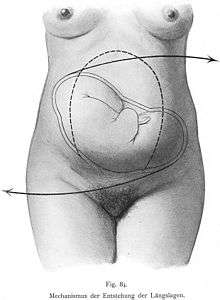
Five causes make up about 80% of newborn deaths. They include prematurity and low-birth-weight, infections, lack of oxygen at birth, and trauma during birth.[17]
Preterm birth
Preterm birth is the birth of an infant at fewer than 37 weeks gestational age. It is estimated that 1 in 10 babies are born prematurely. Premature birth is the leading cause of death in children under 5 years of age though many that survive experience disabilities including learning defects and visual and hearing problems. Causes for early birth may be unknown or may be related to certain chronic conditions such as diabetes, infections, and other known causes. The World Health Organization has developed guidelines with recommendations to improve the chances of survival and health outcomes for preterm infants.[114]
Neonatal infection
_conditions_world_map_-_DALY_-_WHO2004.svg.png)
Newborns are prone to infection in the first month of life. The organism S. agalactiae (Group B Streptococcus) or (GBS) is most often the cause of these occasionally fatal infections. The baby contracts the infection from the mother during labor. In 2014 it was estimated that about one in 2000 newborn babies have GBS bacterial infections within the first week of life, usually evident as respiratory disease, general sepsis, or meningitis.[116]
Untreated sexually transmitted infections (STIs) are associated with congenital and infections in newborn babies, particularly in the areas where rates of infection remain high. The majority of STIs have no symptoms or only mild symptoms that may not be recognized. Mortality rates resulting from some infections may be high, for example the overall perinatal mortality rate associated with untreated syphilis is 30%.[117]
Perinatal asphyxia
Perinatal asphyxia is the medical condition resulting from deprivation of oxygen to a newborn infant that lasts long enough during the birth process to cause physical harm, usually to the brain. Hypoxic damage can occur to most of the infant's organs (heart, lungs, liver, gut, kidneys), but brain damage is of most concern and perhaps the least likely to quickly or completely heal.[118][118]
Mechanical fetal injury
Risk factors for fetal birth injury include fetal macrosomia (big baby), maternal obesity, the need for instrumental delivery, and an inexperienced attendant. Specific situations that can contribute to birth injury include breech presentation and shoulder dystocia. Most fetal birth injuries resolve without long term harm, but brachial plexus injury may lead to Erb's palsy or Klumpke's paralysis.[119]
History
Historically, most women gave birth at home without emergency medical care available. At the onset of the Industrial Revolution, giving birth at home became more difficult due to congested living spaces and dirty living conditions. This drove urban and lower class women to newly available hospitals, while wealthy and middle-class women continued to labor at home.[120] In the early 1900s there was an increasing availability of hospitals, and more women began going into the hospital for labor and delivery. In the United States, the middle classes were especially receptive to the medicalization of childbirth, which promised a safer and less painful labor.[121]
Historically women have been attended and supported by other women during labour and birth. However currently in developed countries, as more women are giving birth in a hospital rather than at home, continuous support has become the exception rather than the norm. In the United States, before the 1950s the husband would not be in the birthing room. It did not matter if it was a home birth; the husband was waiting downstairs or in another room in the home. If it was in a hospital then the husband was in the waiting room. "Her husband was attentive and kind, but, Kirby concluded, Every good woman needs a companion of her own sex."[122]
Society and culture
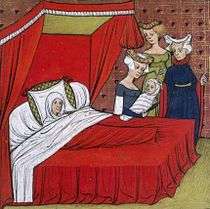
Costs
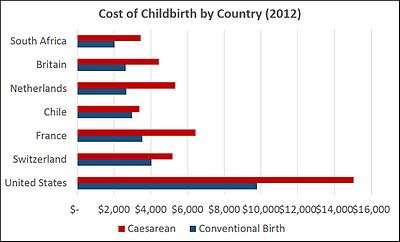
According to a 2013 analysis performed commissioned by the New York Times and performed by Truven Healthcare Analytics, the cost of childbirth varies dramatically by country. In the United States the average amount actually paid by insurance companies or other payers in 2012 averaged $9,775 for an uncomplicated conventional delivery and $15,041 for a caesarean birth.[123] The aggregate charges of healthcare facilities for 4 million annual births in the United States was estimated at over $50 billion. The summed cost of prenatal care, childbirth, and newborn care came to $30,000 for a vaginal delivery and $50,000 for a caesarian section.
In the United States, childbirth hospital stays have some of the lowest ICU utilizations. Vaginal delivery with and without complicating diagnoses and caesarean section with and without comorbidities or major comorbidities account for four of the fifteen types of hospital stays with low rates of ICU utilization (where less than 20% of visits were admitted to the ICU). During stays with ICU services, approximately 20% of costs were attributable to the ICU.[124]
A 2013 study found varying costs by facility for childbirth expenses in California, varying from $3,296 to $37,227 for vaginal birth and from $8,312 to $70,908 for a caesarean birth.[125]
Beginning in 2014, the United Kingdom National Institute for Health and Care Excellence began recommending that many women give birth at home under the care of a midwife rather than an obstetrician, citing lower expenses and better healthcare outcomes.[126] The median cost associated with home birth was estimated to be about $1,500 vs. about $2,500 in hospital.[127]
Location
Childbirth routinely occurs in hospitals in most developed countries. Before the 20th century and in some countries to the present day, such as the Netherlands, it has more typically occurred at home.[128]
The exact location in which childbirth takes place is an important factor in determining nationality, in particular for birth aboard aircraft and ships.
Facilities
Following are facilities that are particularly intended to house women during childbirth:
- A labour ward, also called a delivery ward or labour and delivery, is generally a department of a hospital that focuses on providing health care to women and their children during childbirth. It is generally closely linked to the hospital's neonatal intensive care unit and/or obstetric surgery unit if present. A maternity ward or maternity unit may include facilities both for childbirth and for postpartum rest and observation of mothers in normal as well as complicated cases.
- A maternity hospital is a hospital that specializes in caring for women while they are pregnant and during childbirth and provide care for newborn babies,
- A birthing center generally presents a simulated home-like environment. Birthing centers may be located on hospital grounds or "free standing" (i.e., not hospital-affiliated).
- In addition, it is possible to have a home birth, usually with the assist of a midwife. However, some women choose to give birth at home without any professionals present, termed an unassisted childbirth.
Associated occupations
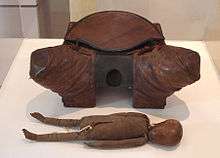
Different categories of birth attendants may provide support and care during pregnancy and childbirth, although there are important differences across categories based on professional training and skills, practice regulations, as well as the nature of care delivered. Many of these occupations are highly professionalised, but other roles exist on a less formal basis.
"Childbirth educators" are instructors who aim to educate pregnant women and their partners about the nature of pregnancy, labour signs and stages, techniques for giving birth, breastfeeding and newborn baby care. Training for this role can be found in hospital settings or through independent certifying organizations. Each organization teaches its own curriculum and each emphasizes different techniques.
Doulas are assistants who support mothers during pregnancy, labour, birth, and postpartum. They are not medical attendants; rather, they provide emotional support and non-medical pain relief for women during labour. Like childbirth educators and other unlicensed assistive personnel, certification to become a doula is not compulsory, thus, anyone can call themself a doula or a childbirth educator.
Confinement nannies are individuals who are employed to provide assistance and stay with the mothers at their home after childbirth. They are usually experienced mothers who took courses on how to take care of mothers and newborn babies.[129]
Midwives are autonomous practitioners who provide basic and emergency health care before, during and after pregnancy and childbirth, generally to women with low-risk pregnancies. Midwives are trained to assist during labour and birth, either through direct-entry or nurse-midwifery education programs. Jurisdictions where midwifery is a regulated profession will typically have a registering and disciplinary body for quality control, such as the American Midwifery Certification Board in the United States,[130] the College of Midwives of British Columbia (CMBC) in Canada[131][132] or the Nursing and Midwifery Council (NMC) in the United Kingdom.[133][134]
In jurisdictions where midwifery is not a regulated profession, traditional or lay midwives may assist women during childbirth, although they do not typically receive formal health care education and training.
Medical doctors who practice obstetrics include categorically specialized obstetricians, family practitioners and general practitioners whose training, skills and practices include obstetrics, and in some contexts general surgeons. These physicians and surgeons variously provide care across the whole spectrum of normal and abnormal births and pathological labour conditions. Categorically specialized obstetricians are qualified surgeons, so they can undertake surgical procedures relating to childbirth. Some family practitioners or general practitioners also perform obstetrical surgery. Obstetrical procedures include cesarean sections, episiotomies, and assisted delivery. Categorical specialists in obstetrics are commonly dually trained in obstetrics and gynecology (OB/GYN), and may provide other medical and surgical gynecological care, and may incorporate more general, well-woman, primary care elements in their practices. Maternal-fetal medicine specialists are obstetrician/gynecologists subspecialized in managing and treating high-risk pregnancy and delivery.
Anaesthetists or anesthesiologists are medical doctors who specialise in pain relief and the use of drugs to facilitate surgery and other painful procedures. They may contribute to the care of a woman in labour by performing epidurals or by providing anaesthesia (often spinal anaesthesia) for Cesarean section or forceps delivery.
Obstetric nurses assist midwives, doctors, women, and babies before, during, and after the birth process, in the hospital system. Obstetric nurses hold various certifications and typically undergo additional obstetric training in addition to standard nursing training.
Paramedics are healthcare providers that are able to provide emergency care to both the mother and infant during and after delivery using a wide range of medications and tools on an ambulance. They are capable of delivering babies but can do very little for infants that become "stuck" and are unable to be delivered vaginally.
Lactation consultants assist the mother and newborn to breastfeed successfully. A health visitor comes to see them at home, usually within 24 hours of discharge, and checks maternal healing and infant development.
Collecting stem cells
It is currently possible to collect two types of stem cells during childbirth: amniotic stem cells and umbilical cord blood stem cells.[135] They are being studied as possible treatments of a number of conditions.[135]
Other aspects
In many countries, age is reckoned from the date of birth, and sometimes the birthday is celebrated annually. East Asian age reckoning starts newborns at "1", incrementing each Lunar New Year.
Some cultures view the placenta as a special part of birth, since it has been the child's life support for so many months. The placenta may be eaten by the newborn's family, ceremonially, for nutrition, or otherwise.[136] (Some animal mothers eat their afterbirth; this is called placentophagy.) Most recently there is a category of birth professionals available who will process the placenta for consumption by postpartum mothers.
See also
- Abuse during childbirth
- Advanced maternal age, when a woman is of an older age at reproduction
- Antinatalism
- Asynclitic birth, an abnormal birth position
- Childbirth positions
- Coffin birth
- Multiple birth
- Obstetrical bleeding
- Naegele's rule, to calculate the due date for a pregnancy
- Natalism
- Obstetrical Dilemma
- Perineal massage
- Pre- and perinatal psychology
- Reproductive Health Supplies Coalition
- Traditional birth attendant
- Unassisted childbirth
- Vernix caseosa
Natural birth topics:
References
- 1 2 Martin, Richard J.; Fanaroff, Avroy A.; Walsh, Michele C. Fanaroff and Martin's Neonatal-Perinatal Medicine: Diseases of the Fetus and Infant. Elsevier Health Sciences. p. 116. ISBN 978-0-323-29537-6. Archived from the original on 2017-09-11.
- 1 2 3 4 5 Education material for teachers of midwifery : midwifery education modules (PDF) (2nd ed.). Geneva [Switzerland]: World Health Organisation. 2008. p. 3. ISBN 978-92-4-154666-9. Archived (PDF) from the original on 2015-02-21.
- 1 2 Memon, HU; Handa, VL (May 2013). "Vaginal childbirth and pelvic floor disorders". Women's health (London, England). 9 (3): 265–77, quiz 276–7. doi:10.2217/whe.13.17. PMC 3877300. PMID 23638782.
- 1 2 Martin, Elizabeth. Concise Colour Medical l.p.Dictionary. Oxford University Press. p. 375. ISBN 978-0-19-968799-2. Archived from the original on 2017-09-11.
- 1 2 "The World Factbook". www.cia.gov. July 11, 2016. Archived from the original on 16 November 2016. Retrieved 30 July 2016.
- ↑ "Preterm birth Fact sheet N°363". WHO. November 2015. Archived from the original on 7 March 2015. Retrieved 30 July 2016.
- ↑ Buck, Germaine M.; Platt, Robert W. (2011). Reproductive and perinatal epidemiology. Oxford: Oxford University Press. p. 163. ISBN 978-0-19-985774-6. Archived from the original on 2017-09-11.
- ↑ Co-Operation, Organisation for Economic; Development (2009). Doing better for children. Paris: OECD. p. 105. ISBN 978-92-64-05934-4. Archived from the original on 2017-09-11.
- ↑ Olsen, O; Clausen, JA (12 September 2012). "Planned hospital birth versus planned home birth". The Cochrane Database of Systematic Reviews (9): CD000352. doi:10.1002/14651858.CD000352.pub2. PMC 4238062. PMID 22972043.
- ↑ Fossard, Esta de; Bailey, Michael (2016). Communication for Behavior Change: Volume lll: Using Entertainment–Education for Distance Education. SAGE Publications India. ISBN 978-93-5150-758-1. Archived from the original on 11 September 2017. Retrieved 31 July 2016.
- 1 2 "Birth". The Columbia Electronic Encyclopedia (6 ed.). Columbia University Press. 2016. Archived from the original on 2016-03-06. Retrieved 2016-07-30 – via Encyclopedia.com.
- 1 2 3 4 5 6 7 8 9 "Pregnancy Labor and Birth". Women's Health. September 27, 2010. Archived from the original on 28 July 2016. Retrieved 31 July 2016.
The first stage begins with the onset of labor and ends when the cervix is fully opened. It is the longest stage of labor, usually lasting about 12 to 19 hours
..
The second stage involves pushing and delivery of your baby. It usually lasts 20 minutes to two hours. - ↑ McDonald, SJ; Middleton, P; Dowswell, T; Morris, PS (11 July 2013). "Effect of timing of umbilical cord clamping of term infants on maternal and neonatal outcomes". The Cochrane Database of Systematic Reviews. 7: CD004074. doi:10.1002/14651858.CD004074.pub3. PMID 23843134.
- ↑ Hofmeyr, GJ; Hannah, M; Lawrie, TA (21 July 2015). "Planned caesarean section for term breech delivery". The Cochrane Database of Systematic Reviews (7): CD000166. doi:10.1002/14651858.CD000166.pub2. PMID 26196961.
- ↑ Childbirth: Labour, Delivery and Immediate Postpartum Care. World Health Organization. 2015. p. Chapter D. ISBN 978-92-4-154935-6. Archived from the original on 11 September 2017. Retrieved 31 July 2016.
- ↑ Molina, G; Weiser, TG; Lipsitz, SR; Esquivel, MM; Uribe-Leitz, T; Azad, T; Shah, N; Semrau, K; Berry, WR; Gawande, AA; Haynes, AB (1 December 2015). "Relationship Between Cesarean Delivery Rate and Maternal and Neonatal Mortality". JAMA. 314 (21): 2263–70. doi:10.1001/jama.2015.15553. PMID 26624825.
- 1 2 World Health Organization. "Newborns: reducing mortality". World Health Organization. Archived from the original on 3 April 2017. Retrieved 1 February 2017.
- ↑ Weber, S.E. (1996). "Cultural aspects of pain in childbearing women". Journal of Obstetric, Gynecologic, & Neonatal Nursing. 25 (1): 67–72. doi:10.1111/j.1552-6909.1996.tb02515.x. PMID 8627405.
- ↑ Callister, L.C.; Khalaf, I.; Semenic, S.; Kartchner, R.; et al. (2003). "The pain of childbirth: perceptions of culturally diverse women". Pain Management Nursing. 4 (4): 145–54. doi:10.1016/S1524-9042(03)00028-6. PMID 14663792.
- ↑ Hodnett, E.D. (2002). "Pain and women's satisfaction with the experience of childbirth: A systematic review". American Journal of Obstetrics and Gynecology. 186 (5 (Supplement)): S160–72. doi:10.1016/S0002-9378(02)70189-0. PMID 12011880.
- ↑ Harms, Rogert W. Does back labor really happen? Archived 2016-02-04 at the Wayback Machine., mayoclinic.com, Retrieved 8 September 2014
- ↑ Meyer, D. (2007). "Selective serotonin reuptake inhibitors and their effects on relationship satisfaction". The Family Journal. 15 (4): 392–397. doi:10.1177/1066480707305470.
- ↑ Bowen, R. (July 12, 2010). "Oxytocin". Hypertexts for Biomedical Sciences. Archived from the original on August 29, 2014. Retrieved 2013-08-18.
- ↑ Zlotnick, C.; Johnson, S.L.; Miller, I.W.; Pearlstein, T.; et al. (2001). "Postpartum depression in women receiving public assistance: Pilot study of an interpersonal-therapy-oriented group intervention". American Journal of Psychiatry. 158 (4): 638–40. doi:10.1176/appi.ajp.158.4.638. PMID 11282702.
- ↑ Chabrol, H.; Teissedre, F.; Saint-Jean, M.; Teisseyre, N.; Sistac, C.; Michaud, C.; Roge, B. (2002). "Detection, prevention and treatment of postpartum depression: A controlled study of 859 patients". L'Encéphale. 28 (1): 65–70. PMID 11963345.
- ↑ Pillitteri, A. (2010). "Chapter 15: Nursing Care of a Family During Labor and Birth". Maternal & Child Health Nursing: Care of the Childbearing & Childrearing Family. Hagerstown, Maryland: Lippincott Williams & Wilkins. p. 350. ISBN 978-1-58255-999-5. Archived from the original on 2014-06-28. Retrieved 2013-08-18.
- ↑ Healthline Staff; Levine, D. (Medical Reviewer) (March 15, 2012). "Types of Forceps Used in Delivery". Healthline. Healthline Networks. Archived from the original on March 1, 2012. Retrieved 2013-08-10.
- ↑ "Cervical Ripening". Medscape. Retrieved May 10, 2018.
- ↑ Kupferminc, M.; Lessing, J. B.; Yaron, Y.; Peyser, M. R. (1993). "Nifedipine versus ritodrine for suppression of preterm labour". BJOG: an International Journal of Obstetrics and Gynaecology. 100 (12): 1090–1094. doi:10.1111/j.1471-0528.1993.tb15171.x.
- ↑ Jokic, M.; Guillois, B.; Cauquelin, B.; Giroux, J. D.; Bessis, J. L.; Morello, R.; Levy, G.; Ballet, J. J. (2000). "Fetal distress increases interleukin-6 and interleukin-8 and decreases tumour necrosis factor-alpha cord blood levels in noninfected full-term neonates". BJOG: an International Journal of Obstetrics and Gynaecology. 107 (3): 420–425. doi:10.1111/j.1471-0528.2000.tb13241.x.
- ↑ Lyrenas, S.; Clason, I.; Ulmsten, U. (2001). "In vivo controlled release of PGE2 from a vaginal insert (0.8 mm, 10 mg) during induction of labour". BJOG: an International Journal of Obstetrics and Gynaecology. 108 (2): 169–178. doi:10.1111/j.1471-0528.2001.00039.x.
- ↑ Giacalone, P. L.; Vignal, J.; Daures, J. P.; Boulot, P.; Hedon, B.; Laffargue, F. (2000). "A randomised evaluation of two techniques of management of the third stage of labour in women at low risk of postpartum haemorrhage". BJOG: an International Journal of Obstetrics and Gynaecology. 107 (3): 396–400. doi:10.1111/j.1471-0528.2000.tb13236.x.
- ↑ Hantoushzadeh, S.; Alhusseini, N.; Lebaschi, A. H. (2007). "The effects of acupuncture during labour on nulliparous women: A randomised controlled trial". The Australian and New Zealand Journal of Obstetrics and Gynaecology. 47 (1): 26–30. doi:10.1111/j.1479-828X.2006.00674.x. PMID 17261096.
- 1 2 3 4 "Labor and delivery, postpartum care". Mayo Clinic. Retrieved May 7, 2018.
- ↑ Novak, Sara. "The Most Popular Time for Babies to Be Born". Washington Post.
- ↑ Reiter, R. J.; Tan, D. X.; Korkmaz, A.; Rosales-Corral, S. A. (2013). "Melatonin and stable circadian rhythms optimize maternal, placental and fetal physiology". Human Reproduction Update. 20 (2): 293–307. doi:10.1093/humupd/dmt054. ISSN 1355-4786. PMID 24132226.
- ↑ Satin, A.J. (July 1, 2013). "Latent phase of labor". UpToDate. Wolters Kluwer. Archived from the original on March 3, 2016. (subscription required)
- ↑ Murray, L.J.; Hennen, L.; Scott, J. (2005). The BabyCenter Essential Guide to Pregnancy and Birth: Expert Advice and Real-World Wisdom from the Top Pregnancy and Parenting Resource. Emmaus, Pennsylvania: Rodale Books. pp. 294–295. ISBN 1-59486-211-7. Retrieved 2013-08-18.
- ↑ Mayo clinic staff. "Cervical effacement and dilation". Mayo Clinic. Archived from the original on 4 December 2016. Retrieved 31 January 2017.
- ↑ "WHO recommendations Intrapartum care for a positive childbirth experience (Recommendation 5)" (PDF). World Health Organization. Retrieved May 6, 2018.
- ↑ Obstetric Data Definitions Issues and Rationale for Change Archived 2013-11-06 at the Wayback Machine., 2012 by ACOG.
- ↑ Boyle A, Reddy UM, Landy HJ, Huang CC, Driggers RW, Laughon SK (Jul 2013). "Primary cesarean delivery in the United States". Obstetrics and gynecology. 122 (1): 33–40. doi:10.1097/AOG.0b013e3182952242. PMC 3713634. PMID 23743454.
- ↑ "WHO recommendations Intrapartum care for a positive childbirth experience (item #3.2.2.)" (PDF). World Health Organization. Retrieved May 6, 2018.
- ↑ Zhang, J.; Troendle, J.F.; Yancey, M.K. (2002). "Reassessing the labor curve in nulliparous women". American Journal of Obstetrics and Gynecology. 187 (4): 824–8. doi:10.1067/mob.2002.127142. PMID 12388957. Archived from the original on 2016-01-18.
- ↑ "Abnormal Labour". Medscape. Retrieved May 14, 2018.
- ↑ "WHO recommendations Intrapartum care for a positive childbirth experience (item #33)" (PDF). World Health Organization. Retrieved May 6, 2018.
- ↑ Rouse, D.J.; Weiner, S.J.; Bloom, S.L.; Varner, M.W.; et al. (2009). "Second-stage labour duration in nulliparous women: Relationship to maternal and perinatal outcomes". American Journal of Obstetrics and Gynecology. 201 (4): 357.e1–7. doi:10.1016/j.ajog.2009.08.003. PMC 2768280. PMID 19788967.
- ↑ Jangsten, E.; Mattsson, L.; Lyckestam, I.; Hellström, A.; et al. (2011). "A comparison of active management and expectant management of the third stage of labour: A Swedish randomised controlled trial". BJOG: an International Journal of Obstetrics & Gynaecology. 118 (3): 362–9. doi:10.1111/j.1471-0528.2010.02800.x. PMID 21134105.
- ↑ Weeks, A.D. (2008). "The retained placenta". Best Practice & Research Clinical Obstetrics & Gynaecology. 22 (6): 1103–17. doi:10.1016/j.bpobgyn.2008.07.005. PMID 18793876.
- ↑ Ball, H. (June 2009). "Active management of the third state of labor is rare in some developing countries". International Perspectives on Sexual and Reproductive Health. 35 (2). Archived from the original on 2016-03-04.
- ↑ Stanton, C.; Armbruster, D; Knight, R.; Ariawan, I.; et al. (February 13, 2009). "Use of active management of the third stage of labour in seven developing countries". Bulletin of the World Health Organization. 87 (3): 207–13. doi:10.2471/BLT.08.052597. PMC 2654655. PMID 19377717.
- ↑ International Confederation of Midwives; International Federation of Gynaecologists Obstetricians (2004). "Joint statement: Management of the third stage of labour to prevent post-partum haemorrhage". Journal of Midwifery & Women's Health. 49 (1): 76–7. doi:10.1016/j.jmwh.2003.11.005. PMID 14710151.
- ↑ Mathai, M.; Gülmezoglu, A.M.; Hill, S. (2007). "WHO recommendations for the prevention of postpartum haemorrhage" (PDF). Geneva: World Health Organization, Department of Making Pregnancy Safer. Archived from the original (PDF) on 2009-07-05.
- ↑ McDonald, SJ; Middleton, P; Dowswell, T; Morris, PS (Jul 11, 2013). McDonald, Susan J, ed. "Effect of timing of umbilical cord clamping of term infants on maternal and neonatal outcomes". The Cochrane Database of Systematic Reviews. 7: CD004074. doi:10.1002/14651858.CD004074.pub3. PMID 23843134.
- ↑ Campbell, Denis. "Hospitals warned to delay cutting umbilical cords after birth". The Guardian. Retrieved June 11, 2018.
- ↑ Gjerdingen, D.K.; Froberg, D.G. (1991). "The fourth stage of labor: The health of birth mothers and adoptive mothers at six-weeks postpartum". Family medicine. 23 (1): 29–35. PMID 2001778.
- 1 2 WHO (2013). "WHO recommendations on postnatal care of the mother and newborn". World Health Organization. Archived from the original on 22 December 2014. Retrieved 22 December 2014.
- ↑ "Postpartum Assessment". ATI Nursing Education. Archived from the original on 24 December 2014. Retrieved 24 December 2014.
- ↑ Mayo clinic staff. "Postpartum care: What to expect after a vaginal delivery". Mayo Clinic. Archived from the original on 21 December 2014. Retrieved 23 December 2014.
- ↑ Saloojee, H. (4 January 2008). "Early skin-to-skin contact for mothers and their healthy newborn infants". The WHO Reproductive Health Library. WHO. Archived from the original on 21 December 2014. Retrieved 23 December 2014.
- ↑ Crenshaw, Jennette (2007). "Care Practice #6: No Separation of Mother and Baby, With Unlimited Opportunities for Breastfeeding". J Perinat Educ. 16: 39–43. doi:10.1624/105812407X217147. PMC 1948089. PMID 18566647.
- ↑ Moore, ER; Bergman, N; Anderson, GC; Medley, N (25 November 2016). "Early skin-to-skin contact for mothers and their healthy newborn infants". The Cochrane Database of Systematic Reviews. 11: CD003519. doi:10.1002/14651858.CD003519.pub4. PMC 3979156. PMID 27885658.
- ↑ Phillips, Raylene. "Uninterrupted Skin-to-Skin Contact Immediately After Birth". Medscape. Archived from the original on 3 April 2015. Retrieved 21 December 2014.
- ↑ "Essential Antenatal, Perinatal and Postpartum Care" (PDF). Promoting Effective Perinatal Care. WHO. Archived (PDF) from the original on 24 September 2015. Retrieved 21 December 2014.
- ↑ "Care of healthy women and their babies during childbirth". National Collaborating Centre for Women's and Children's Health. National Institute for Health and Care Excellence. December 2014. Archived from the original on 12 February 2015. Retrieved 21 December 2014.
- 1 2 "Rates for total cesarean section, primary cesarean section, and vaginal birth after cesarean (VBAC), United States, 1989–2010" (PDF). Childbirth Connection website. Relentless Rise in Cesarian Rate. August 2012. Archived from the original (PDF) on 2013-02-17. Retrieved 2013-08-29.
- ↑ Main, E.; Oshiro, B.; Chagolla, B.; Bingham, D.; et al. (July 2010). "Elimination of Non-medically Indicated (Elective) Deliveries Before 39 Weeks Gestational Age (California Maternal Quality Care Collaborative Toolkit to Transform Maternity Care)" (PDF). Developed under contract #08-85012 with the California Department of Public Health; Maternal, Child and Adolescent Health Division. (1st ed.). March of Dimes. Archived from the original (PDF) on 2012-11-20. Retrieved 2013-08-29.
- ↑ "Recent Declines in Induction of Labor by Gestational Age". Centers for Disease Control and Prevention. Retrieved May 9, 2018.
- ↑ Hamilton, B.E.; Martin, J.A.; Ventura, S.J. (March 18, 2009). "Births: Preliminary data for 2007" (PDF). National Vital Statistics Reports. National Vital Statistics System, National Center for Health Statistics, Centers for Disease Control and Prevention, US Department of Health and Human Services. 57 (12): 1–22. Archived (PDF) from the original on August 21, 2013. Retrieved 2013-08-29.
- ↑ Mozurkewich, E.L.; Chilimigras, J.L.; Berman, D.R.; Perni, U.C.; et al. (October 27, 2011). "Methods of induction of labor: A systematic review". BMC Pregnancy and Childbirth. 11: 84. doi:10.1186/1471-2393-11-84. PMC 3224350. PMID 22032440.
- ↑ ACOG District II Patient Safety and Quality Improvement Committee (December 2011). "Oxytocin for Induction" (PDF). Optimizing Protocols in Obstetrics. Series 1. American Congress of Obstetricians and Gynecologists (ACOG). Archived from the original (PDF) on 2013-06-21. Retrieved 2013-08-29.
- ↑ National Institute for Health and Care Excellence. "Intrapartum care: care of healthy women and their babies during childbirth". National Institute for Health and Care Excellence. Archived from the original on 18 February 2015. Retrieved 11 February 2015.
- ↑ Tranmer, J.E.; Hodnett, E.D.; Hannah, M.E.; Stevens, B.J. (2005). "The effect of unrestricted oral carbohydrate intake on labor progress". Journal of Obstetric, Gynecologic, & Neonatal Nursing. 34 (3): 319–26. doi:10.1177/0884217505276155. PMID 15890830.
- ↑ O'Sullivan, G.; Scrutton, M. (2003). "NPO during labor. Is there any scientific validation?". Anesthesiology Clinics of North America. 21 (1): 87–98. doi:10.1016/S0889-8537(02)00029-9. PMID 12698834.
- ↑ Singata, M.; Tranmer, J.; Gyte, G.M.L. (2013). Singata, Mandisa, ed. Pregnancy and Childbirth Group. "Restricting oral fluid and food intake during labour". Cochrane Database of Systematic Reviews. Cochrane Collaboration. 8: CD003930. doi:10.1002/14651858.CD003930.pub3. PMC 4175539. PMID 23966209. Lay summary – Cochrane Summaries (2013-08-22).
- ↑ Basevi, V; Lavender, T (14 November 2014). "Routine perineal shaving on admission in labour". The Cochrane Database of Systematic Reviews (11): CD001236. doi:10.1002/14651858.CD001236.pub2. PMID 25398160.
- ↑ Lumbiganon, P; Thinkhamrop, J; Thinkhamrop, B; Tolosa, JE (Sep 14, 2014). "Vaginal chlorhexidine during labour for preventing maternal and neonatal infections (excluding Group B Streptococcal and HIV)". The Cochrane Database of Systematic Reviews. 9: CD004070. doi:10.1002/14651858.CD004070.pub3. PMID 25218725.
- ↑ Haas, DM; Morgan, S; Contreras, K (21 December 2014). "Vaginal preparation with antiseptic solution before cesarean section for preventing postoperative infections". The Cochrane Database of Systematic Reviews. 12: CD007892. doi:10.1002/14651858.CD007892.pub5. PMID 25528419.
- ↑ Brown, Heather; Paranjothy S; Dowswell T; Thomas J (September 2013). Brown, Heather C, ed. "Package of care for active management in labour for reducing caesarean section rates in low-risk women". Cochrane Database of Systematic Reviews (9): CD004907. doi:10.1002/14651858.CD004907.pub3. PMC 4161199. PMID 24043476.
- ↑ "Recommendations for Augmentation of Labour" (PDF). World Health Organization. Retrieved May 8, 2018.
- ↑ Jones L, Othman M, Dowswell T, Alfirevic Z, Gates S, Newburn M, Jordan S, Lavender T, Neilson JP (2012). "Pain management for women in labour: an overview of systematic reviews". Reviews. Wiley Online Library. 3: CD009234. doi:10.1002/14651858.CD009234.pub2. PMID 22419342. Archived from the original on 16 July 2017. Retrieved 27 December 2014.
- ↑ "Immersion in Water During Labor and Delivery". Pediatrics. 133 (4): 758–761. 20 March 2014. doi:10.1542/peds.2013-3794.
- 1 2 Hodnett, E.D.; Gates, S.; Hofmeyr, G.J.; Sakala, C. (2013). Hodnett, Ellen D, ed. Pregnancy and Childbirth Group. "Continuous support for women during childbirth". Cochrane Database of Systematic Reviews. 7: CD003766. doi:10.1002/14651858.CD003766.pub5. PMC 4175537. PMID 23857334. Lay summary – Cochrane Summaries (2013-07-15).
- ↑ "Safe Prevention of the Primary Cesarean Delivery". American College of Obstetricians and Gynecologists (the College) and the Society for Maternal-Fetal Medicine. March 2014. Archived from the original on 2 March 2014. Retrieved 20 February 2014.
- ↑ Thorp, J.A.; Breedlove, G. (1996). "Epidural analgesia in labor: An evaluation of risks and benefits". Birth. 23 (2): 63–83. doi:10.1111/j.1523-536X.1996.tb00833.x. PMID 8826170.
- 1 2 Anim-Somuah, M; Smyth, RM; Cyna, AM; Cuthbert, A (21 May 2018). "Epidural versus non-epidural or no analgesia for pain management in labour". The Cochrane Database of Systematic Reviews. 5: CD000331. doi:10.1002/14651858.CD000331.pub4. PMID 29781504.
- ↑ Alehagen, S.; Wijma, B.; Lundberg, U.; Wijma, K. (September 2005). "Fear, pain and stress hormones during childbirth". Journal of Psychosomatic Obstetrics & Gynecology. 26 (3): 153–65. doi:10.1080/01443610400023072. PMID 16295513.
- ↑ Loftus, J.R.; Hill, H.; Cohen, S.E. (August 1995). "Placental transfer and neonatal effects of epidural sufentanil and fentanyl administered with bupivacaine during labor". Anesthesiology. 83 (2): 300–8. doi:10.1097/00000542-199508000-00010. PMID 7631952.
- ↑ Wei, S.Q.; Luo, Z.C.; Xu, H.; Fraser, W.D. (September 2009). "The effect of early oxytocin augmentation in labour: A meta-analysis". Obstetrics & Gynecology. 114 (3): 641–9. doi:10.1097/AOG.0b013e3181b11cb8. PMID 19701046.
- ↑ "Recommendations for Augmentation of Labour" (PDF). World Health Organization. Retrieved May 9, 2018.
- ↑ Jiang, Hong; Qian, Xu; Carroli, Guillermo; Garner, Paul (8 February 2017). "Selective versus routine use of episiotomy for vaginal birth". The Cochrane Database of Systematic Reviews. 2: CD000081. doi:10.1002/14651858.CD000081.pub3. ISSN 1469-493X. PMC 5449575. PMID 28176333.
- ↑ Vernon, D. "Men At Birth – Should Your Bloke Be There?". BellyBelly.com.au. Archived from the original on 2013-06-01. Retrieved 2013-08-23.
- ↑ Hammond, P.; Johnson, A. (1986). "Tocodynamometer". In Brown, M. The Medical Equipment Dictionary. London: Chapman & Hall. ISBN 0-412-28290-9. Archived from the original on 2016-03-04. Retrieved 2013-08-23. Online version accessed.
- ↑ "Continuous cardiotocography (CTG) as a form of electronic fetal monitoring (EFM) for fetal assessment during labour". Cochrane. Retrieved May 6, 2018.
- ↑ "WHO recommendations Intrapartum care for a positive childbirth experience (RECOMMENDATION 17)" (PDF). World Health Organization. Retrieved May 7, 2018.
- 1 2 "Mortality and Burden of Disease Estimates for WHO Member States in 2004" (xls). Department of Measurement and Health Information, World Health Organization. Archived from the original on 2014-02-02.
- ↑ "Maternal health". United Nations Population Fund. Retrieved April 24, 2018.
- ↑ Van Lerberghe, W.; De Brouwere, V. (2001). "Of Blind Alleys and Things That Have Worked: History's Lessons on Reducing Maternal Mortality" (PDF). In De Brouwere, V.; Van Lerberghe, W. Safe Motherhood Strategies: A Review of the Evidence. Studies in Health Services Organisation and Policy. 17. Antwerp: ITG Press. pp. 7–33. ISBN 90-76070-19-9.
Where nothing effective is done to avert maternal death, "natural" mortality is probably of the order of magnitude of 1,500/100,000.
- ↑ "U.S. Has The Worst Rate Of Maternal Deaths In The Developed World". NPR. Retrieved April 25, 2018.
- ↑ "Severe Complications for Women During Childbirth Are Skyrocketing — and Could Often Be Prevented". ProPublica. Retrieved May 4, 2018.
- ↑ Levi, J.; Kohn, D.; Johnson, K. (June 2011). "Healthy Women, Healthy Babies: How health reform can improve the health of women and babies in America" (PDF). Washington, D.C.: Trust for America's Health. Archived (PDF) from the original on 2012-06-24. Retrieved 2013-08-29.
- ↑ Education material for teachers of midwifery : midwifery education modules (PDF) (2nd ed.). Geneva [Switzerland]: World Health Organisation. 2008. pp. 38–44. ISBN 9789241546669. Archived (PDF) from the original on 2015-02-21.
- ↑ Glazener CM, Abdalla M, Stroud P, Naji S, Templeton A, Russell IT (April 1995). "Postnatal maternal morbidity: extent, causes, prevention and treatment". British Journal of Obstetrics and Gynaecology. 102 (4): 282–7. doi:10.1111/j.1471-0528.1995.tb09132.x. PMID 7612509.
- ↑ Thompson JF, Roberts CL, Currie M, Ellwood DA (June 2002). "Prevalence and persistence of health problems after childbirth: associations with parity and method of birth". Birth (Berkeley, Calif.). 29 (2): 83–94. doi:10.1046/j.1523-536X.2002.00167.x. PMID 12051189.
- ↑ Borders N (2006). "After the afterbirth: a critical review of postpartum health relative to method of delivery". Journal of Midwifery & Women's Health. 51 (4): 242–248. doi:10.1016/j.jmwh.2005.10.014. PMID 16814217.
- ↑ Jaju S, Al Kharusi L, Gowri V. Antenatal prevalence of fear associated with childbirth and depressed mood in primigravid women. Indian journal of psychiatry. 2015 Apr;57(2):15
- ↑ Lukasse M, Schei B, Ryding EL, Bidens Study Group. Prevalence and associated factors of fear of childbirth in six European countries. Sexual & Reproductive Healthcare. 2014 Oct 31;5(3):99-106.
- 1 2 "Postpartum Depression Facts". National Institute of Mental Health. Retrieved May 4, 2018.
- ↑ Lapp LK, Agbokou C, Peretti CS, Ferreri F (September 2010). "Management of post traumatic stress disorder after childbirth: a review". J Psychosom Obstet Gynaecol. 31 (3): 113–22. doi:10.3109/0167482X.2010.503330. PMID 20653342.
- ↑ Condon J (February 2010). "Women's mental health: a "wish-list" for the DSM V". Arch Womens Ment Health. 13 (1): 5–10. doi:10.1007/s00737-009-0114-1. PMID 20127444.
- ↑ Martin, Colin (2012). Perinatal Mental Health : a Clinical Guide. Cumbria England: M & K Pub. p. 26. ISBN 9781907830495.
- ↑ Alder J, Stadlmayr W, Tschudin S, Bitzer J (June 2006). "Post-traumatic symptoms after childbirth: what should we offer?". J Psychosom Obstet Gynaecol. 27 (2): 107–12. doi:10.1080/01674820600714632. PMID 16808085.
- 1 2 Jones, I; Chandra, PS; Dazzan, P; Howard, LM (15 November 2014). "Bipolar disorder, affective psychosis, and schizophrenia in pregnancy and the post-partum period". Lancet. 384 (9956): 1789–99. doi:10.1016/S0140-6736(14)61278-2. PMID 25455249.
- ↑ "Preterm Birth". World Health Organization. Retrieved April 26, 2018.
- ↑ "Mortality and Burden of Disease Estimates for WHO Member States in 2004" (xls). Department of Measurement and Health Information, World Health Organization. February 2009.
- ↑ Ohlsson, A; Shah, VS (10 June 2014). "Intrapartum antibiotics for known maternal Group B streptococcal colonization". The Cochrane Database of Systematic Reviews (6): CD007467. doi:10.1002/14651858.CD007467.pub4. PMID 24915629.
- ↑ "Sexually transmitted infections (STIs)". World Health Organization. May 2013. Archived from the original on 2014-11-25. Retrieved 2013-08-30.
- 1 2 Handel, M.; Swaab, H.; De Vries, L.S.; Jongmans, M.J. (2007). "Long-term cognitive and behavioral consequences of neonatal encephalopathy following perinatal asphyxia: A review". European Journal of Pediatrics. 166 (7): 645–54. doi:10.1007/s00431-007-0437-8. PMC 1914268. PMID 17426984.
- ↑ Warwick, R.; Williams, P.L., eds. (1973). Gray's Anatomy (35th British ed.). London: Longman. p. 1046. ISBN 978-0-443-01011-8.
- ↑ Cassidy, Tina (2006). Birth. New York: Atlantic Monthly Press. pp. 54–55. ISBN 0-87113-938-3.
- ↑ Thompson, C.J. (2005). "Consumer Risk Perceptions in a Community of Reflexive Doubt". Journal of Consumer Research. 32 (2): 235–248. doi:10.1086/432233.
- ↑ Leavitt, Judith W. (1988). Brought to Bed: Childbearing in America, 1750–1950. University of Oxford. pp. 90–91. ISBN 978-0-19-505690-7.
- 1 2 "American Way of Birth, Costliest in the World - NYTimes.com". Archived from the original on 2017-01-01.
- ↑ Barrett ML, Smith MW, Elizhauser A, Honigman LS, Pines JM (December 2014). "Utilization of Intensive Care Services, 2011". HCUP Statistical Brief #185. Rockville, MD: Agency for Healthcare Research and Quality. Archived from the original on 2015-04-02.
- ↑ Hsia, RY; Akosa Antwi, Y; Weber, E (2014). "Analysis of variation in charges and prices paid for vaginal and caesarean section births: a cross-sectional study". BMJ Open. 4 (1): e004017. doi:10.1136/bmjopen-2013-004017. PMC 3902513. PMID 24435892. Archived from the original on 2016-04-13.

- ↑ "www.nice.org.uk". Archived from the original on 2015-02-12.
- ↑ "British Regulator Urges Home Births Over Hospitals for Uncomplicated Pregnancies - NYTimes.com". Archived from the original on 2017-03-28.
- ↑ Stearns, P.N., ed. (1993-12-21). Encyclopedia of Social History. Garland Reference Library of Social Sciences. V. 780. London: Taylor & Francis. p. 144. ISBN 978-0-8153-0342-8. Archived from the original on 2016-01-02.
- ↑ "What Is A Confinement Nanny". NannySOS. Archived from the original on 20 December 2016. Retrieved 22 December 2016.
- ↑ "Archived copy". Archived from the original on 2014-02-23. Retrieved 2014-02-20.
- ↑ "Welcome to the College of Midwives of British Columbia". College of Midwives of British Columbia website. Archived from the original on 2013-09-17. Retrieved 2013-08-30.
- ↑ Province of British Columbia (August 21, 2013) [Revised Statues of British Columbia 1996]. "Health Professions Act". Statues and Regulations of British Columbia internet version. Vancouver, British Columbia, Canada: Queens Printer. Archived from the original on August 25, 2013. Retrieved 2013-08-30.
- ↑ "Our role". Nursing & Midwifery Council website. London, England. 2011-08-31 [Created 2010-02-24]. Archived from the original on 2013-09-05. Retrieved 2013-08-30.
- ↑ "The Nursing and Midwifery Order 2001". London, England: Her Majesty's Stationery Office, The National Archives, Ministry of Justice, Her Majesty's Government. 2002. Archived from the original on 2013-08-08.
- 1 2 Dziadosz, M; Basch, RS; Young, BK (March 2016). "Human amniotic fluid: a source of stem cells for possible therapeutic use". American Journal of Obstetrics and Gynecology. 214 (3): 321–7. doi:10.1016/j.ajog.2015.12.061. PMID 26767797.
- ↑ Vernon, D.M.J., ed. (2005). Having a Great Birth in Australia: Twenty Stories of Triumph, Power, Love and Delight from the Women and Men who Brought New Life Into the World. Canberra, Australia: Australian College of Midwives. p. 56. ISBN 978-0-9751674-3-4.
External links
- Spontaneous Vaginal Delivery, Video by Merck Manual Professional Edition
| Wikinews has related news: 17-pound baby born in Russia |
| Wikimedia Commons has media related to Childbirth. |